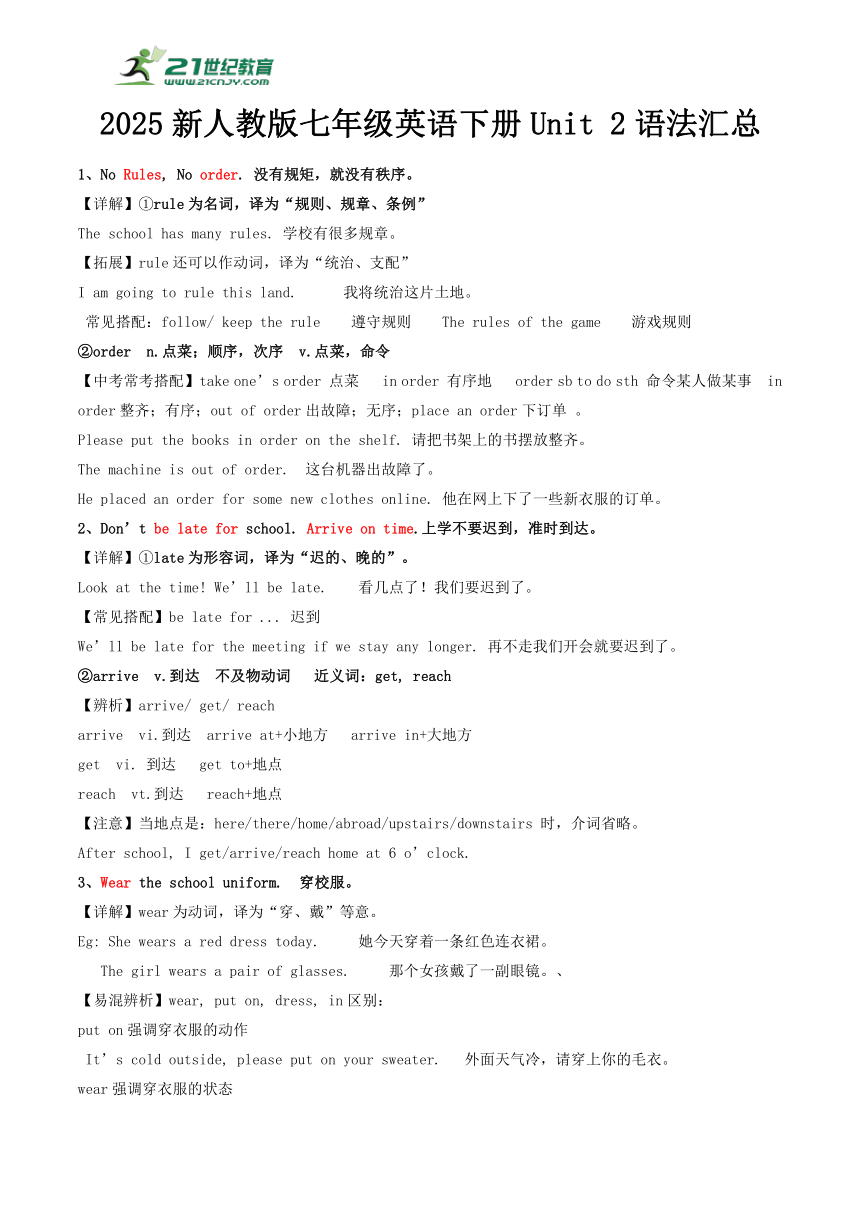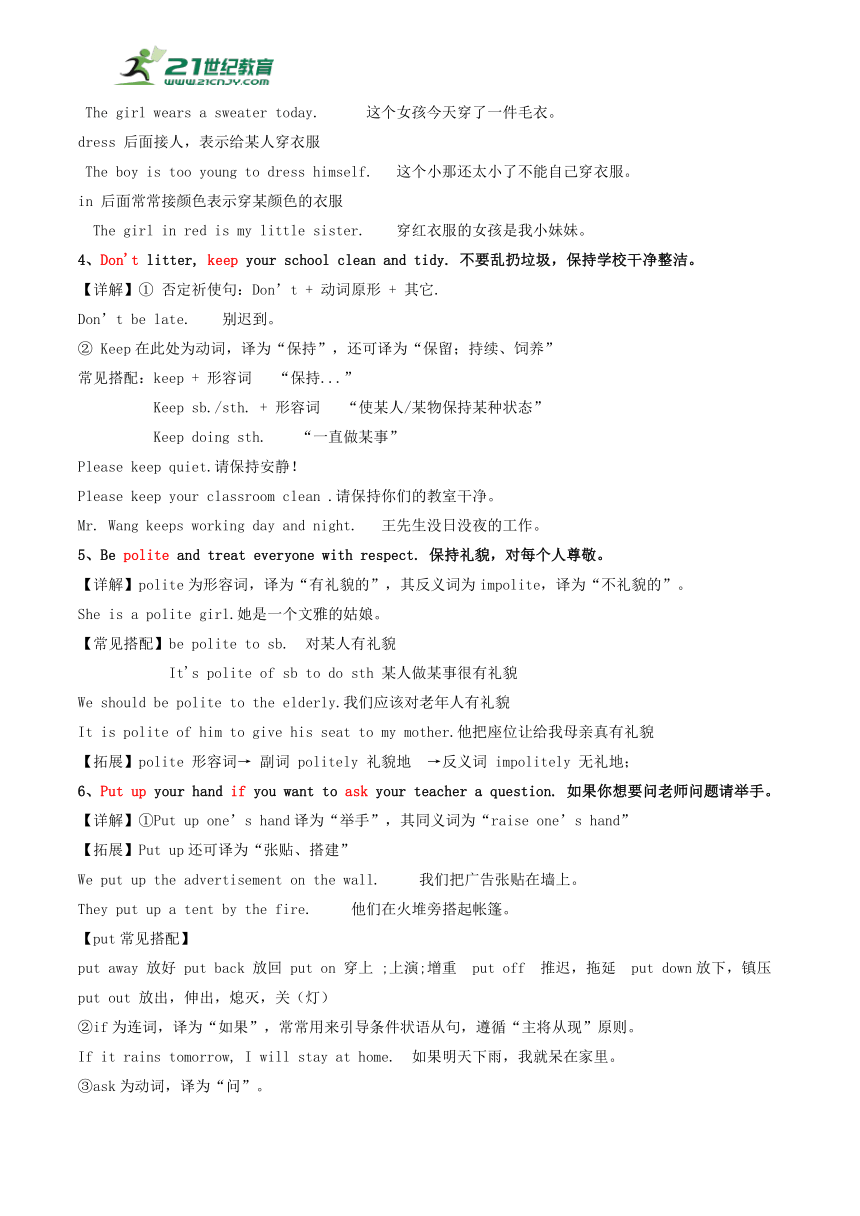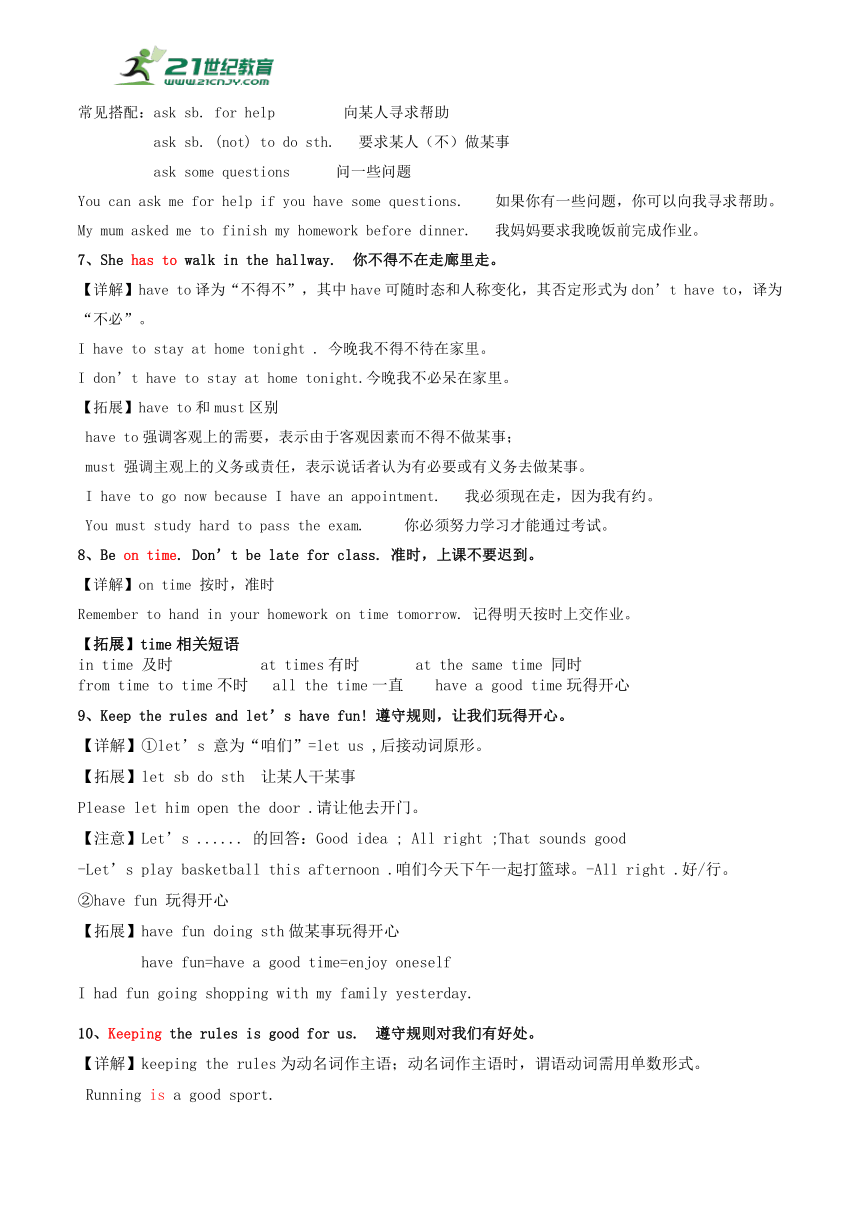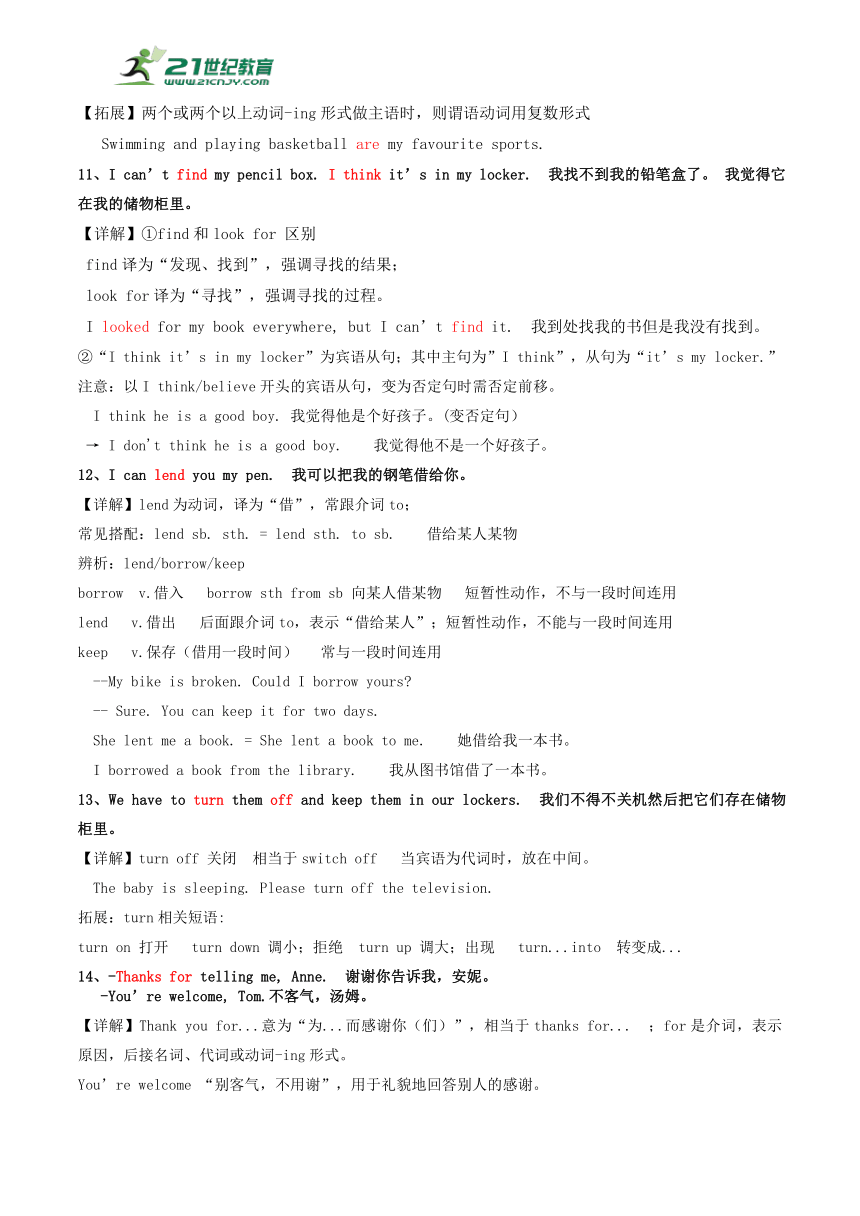Unit 2 No Rules,No Order语法汇总学案-2025新人教版七年级英语下册
文档属性
| 名称 | Unit 2 No Rules,No Order语法汇总学案-2025新人教版七年级英语下册 |  | |
| 格式 | docx | ||
| 文件大小 | 65.0KB | ||
| 资源类型 | 试卷 | ||
| 版本资源 | 人教版 | ||
| 科目 | 英语 | ||
| 更新时间 | 2025-01-11 08:38:09 | ||
图片预览




文档简介
2025新人教版七年级英语下册Unit 2语法汇总
1、No Rules, No order. 没有规矩,就没有秩序。
【详解】①rule为名词,译为“规则、规章、条例”
The school has many rules. 学校有很多规章。
【拓展】rule还可以作动词,译为“统治、支配”
I am going to rule this land. 我将统治这片土地。
常见搭配:follow/ keep the rule 遵守规则 The rules of the game 游戏规则
②order n.点菜;顺序,次序 v.点菜,命令
【中考常考搭配】take one’s order 点菜 in order 有序地 order sb to do sth 命令某人做某事 in order整齐;有序;out of order出故障;无序;place an order下订单 。
Please put the books in order on the shelf. 请把书架上的书摆放整齐。
The machine is out of order. 这台机器出故障了。
He placed an order for some new clothes online. 他在网上下了一些新衣服的订单。
2、Don’t be late for school. Arrive on time.上学不要迟到,准时到达。
【详解】①late为形容词,译为“迟的、晚的”。
Look at the time! We’ll be late. 看几点了!我们要迟到了。
【常见搭配】be late for ... 迟到
We’ll be late for the meeting if we stay any longer. 再不走我们开会就要迟到了。
②arrive v.到达 不及物动词 近义词:get, reach
【辨析】arrive/ get/ reach
arrive vi.到达 arrive at+小地方 arrive in+大地方
get vi. 到达 get to+地点
reach vt.到达 reach+地点
【注意】当地点是:here/there/home/abroad/upstairs/downstairs 时,介词省略。
After school, I get/arrive/reach home at 6 o’clock.
3、Wear the school uniform. 穿校服。
【详解】wear为动词,译为“穿、戴”等意。
Eg: She wears a red dress today. 她今天穿着一条红色连衣裙。
The girl wears a pair of glasses. 那个女孩戴了一副眼镜。、
【易混辨析】wear, put on, dress, in区别:
put on强调穿衣服的动作
It’s cold outside, please put on your sweater. 外面天气冷,请穿上你的毛衣。
wear强调穿衣服的状态
The girl wears a sweater today. 这个女孩今天穿了一件毛衣。
dress 后面接人,表示给某人穿衣服
The boy is too young to dress himself. 这个小那还太小了不能自己穿衣服。
in 后面常常接颜色表示穿某颜色的衣服
The girl in red is my little sister. 穿红衣服的女孩是我小妹妹。
4、Don't litter, keep your school clean and tidy. 不要乱扔垃圾,保持学校干净整洁。
【详解】① 否定祈使句:Don’t + 动词原形 + 其它.
Don’t be late. 别迟到。
② Keep在此处为动词,译为“保持”,还可译为“保留;持续、饲养”
常见搭配:keep + 形容词 “保持...”
Keep sb./sth. + 形容词 “使某人/某物保持某种状态”
Keep doing sth. “一直做某事”
Please keep quiet.请保持安静!
Please keep your classroom clean .请保持你们的教室干净。
Mr. Wang keeps working day and night. 王先生没日没夜的工作。
5、Be polite and treat everyone with respect. 保持礼貌,对每个人尊敬。
【详解】polite为形容词,译为“有礼貌的”,其反义词为impolite,译为“不礼貌的”。
She is a polite girl.她是一个文雅的姑娘。
【常见搭配】be polite to sb. 对某人有礼貌
It's polite of sb to do sth 某人做某事很有礼貌
We should be polite to the elderly.我们应该对老年人有礼貌
It is polite of him to give his seat to my mother.他把座位让给我母亲真有礼貌
【拓展】polite 形容词→ 副词 politely 礼貌地 →反义词 impolitely 无礼地;
6、Put up your hand if you want to ask your teacher a question. 如果你想要问老师问题请举手。
【详解】①Put up one’s hand译为“举手”,其同义词为“raise one’s hand”
【拓展】Put up还可译为“张贴、搭建”
We put up the advertisement on the wall. 我们把广告张贴在墙上。
They put up a tent by the fire. 他们在火堆旁搭起帐篷。
【put常见搭配】
put away 放好 put back 放回 put on 穿上 ;上演;增重 put off 推迟,拖延 put down放下,镇压
put out 放出,伸出,熄灭,关(灯)
②if为连词,译为“如果”,常常用来引导条件状语从句,遵循“主将从现”原则。
If it rains tomorrow, I will stay at home. 如果明天下雨,我就呆在家里。
③ask为动词,译为“问”。
常见搭配:ask sb. for help 向某人寻求帮助
ask sb. (not) to do sth. 要求某人(不)做某事
ask some questions 问一些问题
You can ask me for help if you have some questions. 如果你有一些问题,你可以向我寻求帮助。
My mum asked me to finish my homework before dinner. 我妈妈要求我晚饭前完成作业。
7、She has to walk in the hallway. 你不得不在走廊里走。
【详解】have to译为“不得不”,其中have可随时态和人称变化,其否定形式为don’t have to,译为“不必”。
I have to stay at home tonight . 今晚我不得不待在家里。
I don’t have to stay at home tonight.今晚我不必呆在家里。
【拓展】have to和must区别
have to强调客观上的需要,表示由于客观因素而不得不做某事;
must 强调主观上的义务或责任,表示说话者认为有必要或有义务去做某事。
I have to go now because I have an appointment. 我必须现在走,因为我有约。
You must study hard to pass the exam. 你必须努力学习才能通过考试。
8、Be on time. Don’t be late for class. 准时,上课不要迟到。
【详解】on time 按时,准时
Remember to hand in your homework on time tomorrow. 记得明天按时上交作业。
【拓展】time相关短语
in time 及时 at times有时 at the same time 同时
from time to time不时 all the time一直 have a good time玩得开心
9、Keep the rules and let’s have fun! 遵守规则,让我们玩得开心。
【详解】①let’s 意为“咱们”=let us ,后接动词原形。
【拓展】let sb do sth 让某人干某事
Please let him open the door .请让他去开门。
【注意】Let’s ...... 的回答:Good idea ; All right ;That sounds good
-Let’s play basketball this afternoon .咱们今天下午一起打篮球。-All right .好/行。
②have fun 玩得开心
【拓展】have fun doing sth做某事玩得开心
have fun=have a good time=enjoy oneself
I had fun going shopping with my family yesterday.
10、Keeping the rules is good for us. 遵守规则对我们有好处。
【详解】keeping the rules为动名词作主语;动名词作主语时,谓语动词需用单数形式。
Running is a good sport.
【拓展】两个或两个以上动词-ing形式做主语时,则谓语动词用复数形式
Swimming and playing basketball are my favourite sports.
11、I can’t find my pencil box. I think it’s in my locker. 我找不到我的铅笔盒了。 我觉得它在我的储物柜里。
【详解】①find和look for 区别
find译为“发现、找到”,强调寻找的结果;
look for译为“寻找”,强调寻找的过程。
I looked for my book everywhere, but I can’t find it. 我到处找我的书但是我没有找到。
②“I think it’s in my locker”为宾语从句;其中主句为”I think”,从句为“it’s my locker.”
注意:以I think/believe开头的宾语从句,变为否定句时需否定前移。
I think he is a good boy. 我觉得他是个好孩子。(变否定句)
→ I don't think he is a good boy. 我觉得他不是一个好孩子。
12、I can lend you my pen. 我可以把我的钢笔借给你。
【详解】lend为动词,译为“借”,常跟介词to;
常见搭配:lend sb. sth. = lend sth. to sb. 借给某人某物
辨析:lend/borrow/keep
borrow v.借入 borrow sth from sb 向某人借某物 短暂性动作,不与一段时间连用
lend v.借出 后面跟介词to,表示“借给某人”;短暂性动作,不能与一段时间连用
keep v.保存(借用一段时间) 常与一段时间连用
--My bike is broken. Could I borrow yours
-- Sure. You can keep it for two days.
She lent me a book. = She lent a book to me. 她借给我一本书。
I borrowed a book from the library. 我从图书馆借了一本书。
13、We have to turn them off and keep them in our lockers. 我们不得不关机然后把它们存在储物柜里。
【详解】turn off 关闭 相当于switch off 当宾语为代词时,放在中间。
The baby is sleeping. Please turn off the television.
拓展:turn相关短语:
turn on 打开 turn down 调小;拒绝 turn up 调大;出现 turn...into 转变成...
14、-Thanks for telling me, Anne. 谢谢你告诉我,安妮。
-You’re welcome, Tom.不客气,汤姆。
【详解】Thank you for...意为“为...而感谢你(们)”,相当于thanks for... ;for是介词,表示原因,后接名词、代词或动词-ing形式。
You’re welcome “别客气,不用谢”,用于礼貌地回答别人的感谢。
【拓展】常用的答语还有Not at all. /That’s OK. /That’s all right. / (It’s)my pleasure...
15、Don’t jump the queue. You must wait for your turn. 不要插队。你必须等着轮到你。
【详解】wait为动词,译为“等待”。
【词组】wait for sb 等候某人
wait for sb to do sth 等候某人干某事
can’t wait to do sth 迫不及待干某事
Someone is waiting for you there. 在那儿有人在等候你。
We are waiting for him to go shopping now .现在我们正在等候他一起去购物。
I can’t wait to meet my parents .我迫不及待要见我的父母。
16、But you must tell your teacher about it when you have to be absent from class.但是当你不得不缺课时你必须告诉你的老师。
【详解】①tell 动词 告诉
【词组】tell sb about sth 告诉某人关于某东西
tell sb to do sth 告诉某人干某事
tell sb not to do sth 告诉某人不要干某事
Our teacher told us not to play football on the road .我们老师告诉我们不要在道路上踢足球。
②absent为形容词,译为“缺席的”,其名词形式为absence。
【词组】be absent from... 缺席......
He is often absent from school .他经常缺课。
17、We must keep quiet. We mustn’t make noise. 我们必须保持安静。我们不准制造噪音。
【详解】①quiet为形容词,译为“安静的、宁静的、文静的”,其副词形式为quietly。
常见搭配: be quiet = keep quiet 保持安静。
Be quiet ,my father is sleeping .保持安静,我爸爸正在睡觉。
②noise为不可数名词,译为“噪音”;其形容词形式为noisy,译为“吵闹的”。
常见搭配:make noise 制造噪音
【拓展】sound, voice与noise区别:
sound泛指任何声音,不论其高低、是否悦耳等。
I heard the sound of running water. 我听见流水声。
noise表示噪音、喧闹,指的是人们不愿听到的声音或嘈杂声。它既可以作可数名词,也可以作不可数名词。There’s a lot of noise here. 这个地方人声嘈杂。
voice用于人时,指说话、歌唱或发笑的声音,也可指发言权。用于其他方面时,常含悦耳之声,如鸟鸣声,乐器声音等。
Please speak in a louder voice. 请大声说。
18、I have to hurry to school because I can’t be late for school. 我必须快点上学因为上学不能迟到。
【详解】hurry为动词,译为“赶紧,匆忙”;hurry也可为名词,译为“赶紧、匆忙”。
【词组】hurry to do sth. 匆忙做某事
hurry to+地方 匆忙去某地
in a hurry 匆忙、急切
hurry up 快点、赶快
I go to school in a hurry without having breakfast.我没有吃早餐就匆忙去上学。
19、I have to finish my homework first. 我必须先完成我的作业。
【详解】finish为动词,译为“完成、结束”。相当于“be over”
常见搭配:finish doing sth. 结束做某事
I finally finished doing my homework. 我最后完成了作业。
20、I can only play basketball after I practise the piano.我练习完钢琴后才能打篮球。
【详解】①play basketball 打篮球
play后接球类或棋牌类时无需加定冠词,后面接乐器时需加定冠词the。play+球/棋类 play the+乐器类
My sister likes playing the piano while I like playing basketball.
②practise v. 练习 其名词 practice 练习
【词组】practise doing sth练习做某事
I practise playing football for one hour after school .我明天放学后训练足球一个小时。
21、I know it’s hard, but rules can help to make the world better. 我知道那很难,但是规则可以帮助让世界变得更好。
【详解】①hard为形容词,译为“难的”,相当于difficult;也可译为“坚固的、结实的”;
It’s hard(difficult) for me to work out the problem .对我来说,解决这个问题很难。
【拓展】 hard 与hardly 区别
hard也可为副词,译为“努力地、猛烈地”。
hardly 意思是“几乎不”,表“否定”含义。
It's raining hard now,I hardly go out . 现在正在下大雨,我几乎不能出去。
②make在此处为动词,译为“使成为”,也可译为“制作”
常见搭配:make a cake 做蛋糕
make sb./sth + 形容词 使某人/某事处于某种状态
make sb. do sth. 使某人某事
The story makes me happy. 这个故事让我快乐。
The story make me cry. 这个故事使我感到流泪。
22、Don’t fight with your classmates.不要和你的同学打架。
【详解】fight v.打架;战斗 ;fight也可作名词,译为“打架”
【词组】fight with sb 和某人打架
fight against sb 和某人作战
fight for...为...而斗争
My grandfather fought against the Fascists in Spain.我的祖父在西班牙与法西斯作战。
They are fighting for the peace. 他们正在为和平而战。
单元语法
祈使句
一、定义
用于表达请求、命令、建议、禁止等的句子叫祈使句。祈使句一般没有主语,实际上是省略了“You”。句末用感叹号或句号,读降调。例如:
(1)Go and wash your hands. 去洗你的手。(命令)
(2)Be quiet, please. 请安静。(请求)
(3)Practice the guitar every day. 每天练习吉他。(劝告)
补充:
(1) 有时将主语you表示出来是为了加强语气或表示“不高兴”、“厌烦”、“鄙视”等情绪。
如: You, get out of here! 你,从这里出去!
(2)表示礼貌,常在句首或句末加 please
如:Please stand up. 或 Stand up, please. 请起立。
二、句型
类型 句型结构 示例
Do型 (表示行为的动词原形) 肯定:动词原型+其他 Open the door! Stand up! Sit down!
否定:Don’t+动词原型+其他 Don’t open the door! Don’t eat in classroom!
Be型 肯定:Be+其他 Be quiet! Be careful!
否定:Don’t+be +其他 Don’t be quiet! Don’t be late!
let型 肯定:let sb do sth Let me help you.
否定:Don’t let sb do sth/ Let sb not do sth Don’t let him go. Let him not go.
注意:表示禁止,常用于标语的否定祈使句:
No +doing ! / No +可数名词复数/不可数名词!
No smoking! = Don’t smoke! No photos! = Don’t take photos!
情态动词can/must/have to
一、can的用法
can是情态动词,意为"能;会",表示某人或某物具备的能力,还可用来提出请求,没有人称和数的变化,后面直接接动词原形。下面来看一下它的具体用法。
1. 表示有能力做某事,意为"能;会"。
I can speak English.我会讲英语。
He can play basketball.他会打篮球。[来
2. 表示许可,意为"可以"。
You can sit here.你可以坐在这儿。
3. 情态动词can表示推测,意为"可能",常用语否定句、疑问句中。
It can’t be a cat. It has a short tail. 它不可能是猫,它有一个短尾巴。
二、must的用法
(1)must表示主观义务,意思是"应该,必须",其否定式mustn’t意为"不应该,不准"。情态动词不能单独作谓语动词,必须和动词原形一起构成谓语。
We must get there before five o’clock. 我们必须在五点钟前赶到那儿。
You mustn’t break the rules. 你不要破坏规定。
He must have seen the film last night. 他昨天晚上肯定看了那场电影。
You must read a book before you watch TV. 在看电视前你必须读书。
对用must所提问题的否定回答,常用needn’t或don’t have to,意思为:不必。
Must I stay here after school 放学后我还得留在这儿吗?
No, you needn’t / don’t have to. 不了,没有必要。
(2)must表示推测,意思为:一定,必定(只用于肯定句中)。
He must be our headmaster. 他肯定是我们的校长。
(3)must用于否定句时,mustn’t意为"不允许,禁止",而不表示"不必"。
You mustn’t be late for school. 你千万不要上学迟到。
(4)以must开头的一般疑问句,若作否定回答,可以用needn’t或don’t have to,不用mustn’t。
—Must I clean all the rooms 我必须打扫所有的房间吗?
—No, you needn’t/don’t have to. 不,你不必。
have to的用法
表示客观要求,意思为:不得不;必须;除此之外,别无选择。使用have to应注意以下几点:
(1)have to后接动词原形,意为"必须做……;不得不做……"。
We have no food home, you have to go and get some, Tom. 家里没有食物了,汤姆你得去买一些来。
(2)have to 有人称、数和时态的变化,其第三人称单数形式为has to。
She has to help her mom make dinner. 她不得不帮她妈妈做晚饭。
There’s no bus here, so we had to walk home. 现在这里没有汽车了,我们只好走路回家了。
(3)含有have to, has to的句子需分别借助动词do, does构成疑问句或否定句。
Do they have to go now 他们得现在回家吗?
You don’t have to go if you don’t want to. 如果你不想去,你就不必去。
辨析:have to可以用于多种时态;而must只用于一般现在时或一般将来时。
The composition is due to hand in this morning, so I had to finish it last night.
作文今天早晨到期,因此我不得不昨天晚上完成。
1、No Rules, No order. 没有规矩,就没有秩序。
【详解】①rule为名词,译为“规则、规章、条例”
The school has many rules. 学校有很多规章。
【拓展】rule还可以作动词,译为“统治、支配”
I am going to rule this land. 我将统治这片土地。
常见搭配:follow/ keep the rule 遵守规则 The rules of the game 游戏规则
②order n.点菜;顺序,次序 v.点菜,命令
【中考常考搭配】take one’s order 点菜 in order 有序地 order sb to do sth 命令某人做某事 in order整齐;有序;out of order出故障;无序;place an order下订单 。
Please put the books in order on the shelf. 请把书架上的书摆放整齐。
The machine is out of order. 这台机器出故障了。
He placed an order for some new clothes online. 他在网上下了一些新衣服的订单。
2、Don’t be late for school. Arrive on time.上学不要迟到,准时到达。
【详解】①late为形容词,译为“迟的、晚的”。
Look at the time! We’ll be late. 看几点了!我们要迟到了。
【常见搭配】be late for ... 迟到
We’ll be late for the meeting if we stay any longer. 再不走我们开会就要迟到了。
②arrive v.到达 不及物动词 近义词:get, reach
【辨析】arrive/ get/ reach
arrive vi.到达 arrive at+小地方 arrive in+大地方
get vi. 到达 get to+地点
reach vt.到达 reach+地点
【注意】当地点是:here/there/home/abroad/upstairs/downstairs 时,介词省略。
After school, I get/arrive/reach home at 6 o’clock.
3、Wear the school uniform. 穿校服。
【详解】wear为动词,译为“穿、戴”等意。
Eg: She wears a red dress today. 她今天穿着一条红色连衣裙。
The girl wears a pair of glasses. 那个女孩戴了一副眼镜。、
【易混辨析】wear, put on, dress, in区别:
put on强调穿衣服的动作
It’s cold outside, please put on your sweater. 外面天气冷,请穿上你的毛衣。
wear强调穿衣服的状态
The girl wears a sweater today. 这个女孩今天穿了一件毛衣。
dress 后面接人,表示给某人穿衣服
The boy is too young to dress himself. 这个小那还太小了不能自己穿衣服。
in 后面常常接颜色表示穿某颜色的衣服
The girl in red is my little sister. 穿红衣服的女孩是我小妹妹。
4、Don't litter, keep your school clean and tidy. 不要乱扔垃圾,保持学校干净整洁。
【详解】① 否定祈使句:Don’t + 动词原形 + 其它.
Don’t be late. 别迟到。
② Keep在此处为动词,译为“保持”,还可译为“保留;持续、饲养”
常见搭配:keep + 形容词 “保持...”
Keep sb./sth. + 形容词 “使某人/某物保持某种状态”
Keep doing sth. “一直做某事”
Please keep quiet.请保持安静!
Please keep your classroom clean .请保持你们的教室干净。
Mr. Wang keeps working day and night. 王先生没日没夜的工作。
5、Be polite and treat everyone with respect. 保持礼貌,对每个人尊敬。
【详解】polite为形容词,译为“有礼貌的”,其反义词为impolite,译为“不礼貌的”。
She is a polite girl.她是一个文雅的姑娘。
【常见搭配】be polite to sb. 对某人有礼貌
It's polite of sb to do sth 某人做某事很有礼貌
We should be polite to the elderly.我们应该对老年人有礼貌
It is polite of him to give his seat to my mother.他把座位让给我母亲真有礼貌
【拓展】polite 形容词→ 副词 politely 礼貌地 →反义词 impolitely 无礼地;
6、Put up your hand if you want to ask your teacher a question. 如果你想要问老师问题请举手。
【详解】①Put up one’s hand译为“举手”,其同义词为“raise one’s hand”
【拓展】Put up还可译为“张贴、搭建”
We put up the advertisement on the wall. 我们把广告张贴在墙上。
They put up a tent by the fire. 他们在火堆旁搭起帐篷。
【put常见搭配】
put away 放好 put back 放回 put on 穿上 ;上演;增重 put off 推迟,拖延 put down放下,镇压
put out 放出,伸出,熄灭,关(灯)
②if为连词,译为“如果”,常常用来引导条件状语从句,遵循“主将从现”原则。
If it rains tomorrow, I will stay at home. 如果明天下雨,我就呆在家里。
③ask为动词,译为“问”。
常见搭配:ask sb. for help 向某人寻求帮助
ask sb. (not) to do sth. 要求某人(不)做某事
ask some questions 问一些问题
You can ask me for help if you have some questions. 如果你有一些问题,你可以向我寻求帮助。
My mum asked me to finish my homework before dinner. 我妈妈要求我晚饭前完成作业。
7、She has to walk in the hallway. 你不得不在走廊里走。
【详解】have to译为“不得不”,其中have可随时态和人称变化,其否定形式为don’t have to,译为“不必”。
I have to stay at home tonight . 今晚我不得不待在家里。
I don’t have to stay at home tonight.今晚我不必呆在家里。
【拓展】have to和must区别
have to强调客观上的需要,表示由于客观因素而不得不做某事;
must 强调主观上的义务或责任,表示说话者认为有必要或有义务去做某事。
I have to go now because I have an appointment. 我必须现在走,因为我有约。
You must study hard to pass the exam. 你必须努力学习才能通过考试。
8、Be on time. Don’t be late for class. 准时,上课不要迟到。
【详解】on time 按时,准时
Remember to hand in your homework on time tomorrow. 记得明天按时上交作业。
【拓展】time相关短语
in time 及时 at times有时 at the same time 同时
from time to time不时 all the time一直 have a good time玩得开心
9、Keep the rules and let’s have fun! 遵守规则,让我们玩得开心。
【详解】①let’s 意为“咱们”=let us ,后接动词原形。
【拓展】let sb do sth 让某人干某事
Please let him open the door .请让他去开门。
【注意】Let’s ...... 的回答:Good idea ; All right ;That sounds good
-Let’s play basketball this afternoon .咱们今天下午一起打篮球。-All right .好/行。
②have fun 玩得开心
【拓展】have fun doing sth做某事玩得开心
have fun=have a good time=enjoy oneself
I had fun going shopping with my family yesterday.
10、Keeping the rules is good for us. 遵守规则对我们有好处。
【详解】keeping the rules为动名词作主语;动名词作主语时,谓语动词需用单数形式。
Running is a good sport.
【拓展】两个或两个以上动词-ing形式做主语时,则谓语动词用复数形式
Swimming and playing basketball are my favourite sports.
11、I can’t find my pencil box. I think it’s in my locker. 我找不到我的铅笔盒了。 我觉得它在我的储物柜里。
【详解】①find和look for 区别
find译为“发现、找到”,强调寻找的结果;
look for译为“寻找”,强调寻找的过程。
I looked for my book everywhere, but I can’t find it. 我到处找我的书但是我没有找到。
②“I think it’s in my locker”为宾语从句;其中主句为”I think”,从句为“it’s my locker.”
注意:以I think/believe开头的宾语从句,变为否定句时需否定前移。
I think he is a good boy. 我觉得他是个好孩子。(变否定句)
→ I don't think he is a good boy. 我觉得他不是一个好孩子。
12、I can lend you my pen. 我可以把我的钢笔借给你。
【详解】lend为动词,译为“借”,常跟介词to;
常见搭配:lend sb. sth. = lend sth. to sb. 借给某人某物
辨析:lend/borrow/keep
borrow v.借入 borrow sth from sb 向某人借某物 短暂性动作,不与一段时间连用
lend v.借出 后面跟介词to,表示“借给某人”;短暂性动作,不能与一段时间连用
keep v.保存(借用一段时间) 常与一段时间连用
--My bike is broken. Could I borrow yours
-- Sure. You can keep it for two days.
She lent me a book. = She lent a book to me. 她借给我一本书。
I borrowed a book from the library. 我从图书馆借了一本书。
13、We have to turn them off and keep them in our lockers. 我们不得不关机然后把它们存在储物柜里。
【详解】turn off 关闭 相当于switch off 当宾语为代词时,放在中间。
The baby is sleeping. Please turn off the television.
拓展:turn相关短语:
turn on 打开 turn down 调小;拒绝 turn up 调大;出现 turn...into 转变成...
14、-Thanks for telling me, Anne. 谢谢你告诉我,安妮。
-You’re welcome, Tom.不客气,汤姆。
【详解】Thank you for...意为“为...而感谢你(们)”,相当于thanks for... ;for是介词,表示原因,后接名词、代词或动词-ing形式。
You’re welcome “别客气,不用谢”,用于礼貌地回答别人的感谢。
【拓展】常用的答语还有Not at all. /That’s OK. /That’s all right. / (It’s)my pleasure...
15、Don’t jump the queue. You must wait for your turn. 不要插队。你必须等着轮到你。
【详解】wait为动词,译为“等待”。
【词组】wait for sb 等候某人
wait for sb to do sth 等候某人干某事
can’t wait to do sth 迫不及待干某事
Someone is waiting for you there. 在那儿有人在等候你。
We are waiting for him to go shopping now .现在我们正在等候他一起去购物。
I can’t wait to meet my parents .我迫不及待要见我的父母。
16、But you must tell your teacher about it when you have to be absent from class.但是当你不得不缺课时你必须告诉你的老师。
【详解】①tell 动词 告诉
【词组】tell sb about sth 告诉某人关于某东西
tell sb to do sth 告诉某人干某事
tell sb not to do sth 告诉某人不要干某事
Our teacher told us not to play football on the road .我们老师告诉我们不要在道路上踢足球。
②absent为形容词,译为“缺席的”,其名词形式为absence。
【词组】be absent from... 缺席......
He is often absent from school .他经常缺课。
17、We must keep quiet. We mustn’t make noise. 我们必须保持安静。我们不准制造噪音。
【详解】①quiet为形容词,译为“安静的、宁静的、文静的”,其副词形式为quietly。
常见搭配: be quiet = keep quiet 保持安静。
Be quiet ,my father is sleeping .保持安静,我爸爸正在睡觉。
②noise为不可数名词,译为“噪音”;其形容词形式为noisy,译为“吵闹的”。
常见搭配:make noise 制造噪音
【拓展】sound, voice与noise区别:
sound泛指任何声音,不论其高低、是否悦耳等。
I heard the sound of running water. 我听见流水声。
noise表示噪音、喧闹,指的是人们不愿听到的声音或嘈杂声。它既可以作可数名词,也可以作不可数名词。There’s a lot of noise here. 这个地方人声嘈杂。
voice用于人时,指说话、歌唱或发笑的声音,也可指发言权。用于其他方面时,常含悦耳之声,如鸟鸣声,乐器声音等。
Please speak in a louder voice. 请大声说。
18、I have to hurry to school because I can’t be late for school. 我必须快点上学因为上学不能迟到。
【详解】hurry为动词,译为“赶紧,匆忙”;hurry也可为名词,译为“赶紧、匆忙”。
【词组】hurry to do sth. 匆忙做某事
hurry to+地方 匆忙去某地
in a hurry 匆忙、急切
hurry up 快点、赶快
I go to school in a hurry without having breakfast.我没有吃早餐就匆忙去上学。
19、I have to finish my homework first. 我必须先完成我的作业。
【详解】finish为动词,译为“完成、结束”。相当于“be over”
常见搭配:finish doing sth. 结束做某事
I finally finished doing my homework. 我最后完成了作业。
20、I can only play basketball after I practise the piano.我练习完钢琴后才能打篮球。
【详解】①play basketball 打篮球
play后接球类或棋牌类时无需加定冠词,后面接乐器时需加定冠词the。play+球/棋类 play the+乐器类
My sister likes playing the piano while I like playing basketball.
②practise v. 练习 其名词 practice 练习
【词组】practise doing sth练习做某事
I practise playing football for one hour after school .我明天放学后训练足球一个小时。
21、I know it’s hard, but rules can help to make the world better. 我知道那很难,但是规则可以帮助让世界变得更好。
【详解】①hard为形容词,译为“难的”,相当于difficult;也可译为“坚固的、结实的”;
It’s hard(difficult) for me to work out the problem .对我来说,解决这个问题很难。
【拓展】 hard 与hardly 区别
hard也可为副词,译为“努力地、猛烈地”。
hardly 意思是“几乎不”,表“否定”含义。
It's raining hard now,I hardly go out . 现在正在下大雨,我几乎不能出去。
②make在此处为动词,译为“使成为”,也可译为“制作”
常见搭配:make a cake 做蛋糕
make sb./sth + 形容词 使某人/某事处于某种状态
make sb. do sth. 使某人某事
The story makes me happy. 这个故事让我快乐。
The story make me cry. 这个故事使我感到流泪。
22、Don’t fight with your classmates.不要和你的同学打架。
【详解】fight v.打架;战斗 ;fight也可作名词,译为“打架”
【词组】fight with sb 和某人打架
fight against sb 和某人作战
fight for...为...而斗争
My grandfather fought against the Fascists in Spain.我的祖父在西班牙与法西斯作战。
They are fighting for the peace. 他们正在为和平而战。
单元语法
祈使句
一、定义
用于表达请求、命令、建议、禁止等的句子叫祈使句。祈使句一般没有主语,实际上是省略了“You”。句末用感叹号或句号,读降调。例如:
(1)Go and wash your hands. 去洗你的手。(命令)
(2)Be quiet, please. 请安静。(请求)
(3)Practice the guitar every day. 每天练习吉他。(劝告)
补充:
(1) 有时将主语you表示出来是为了加强语气或表示“不高兴”、“厌烦”、“鄙视”等情绪。
如: You, get out of here! 你,从这里出去!
(2)表示礼貌,常在句首或句末加 please
如:Please stand up. 或 Stand up, please. 请起立。
二、句型
类型 句型结构 示例
Do型 (表示行为的动词原形) 肯定:动词原型+其他 Open the door! Stand up! Sit down!
否定:Don’t+动词原型+其他 Don’t open the door! Don’t eat in classroom!
Be型 肯定:Be+其他 Be quiet! Be careful!
否定:Don’t+be +其他 Don’t be quiet! Don’t be late!
let型 肯定:let sb do sth Let me help you.
否定:Don’t let sb do sth/ Let sb not do sth Don’t let him go. Let him not go.
注意:表示禁止,常用于标语的否定祈使句:
No +doing ! / No +可数名词复数/不可数名词!
No smoking! = Don’t smoke! No photos! = Don’t take photos!
情态动词can/must/have to
一、can的用法
can是情态动词,意为"能;会",表示某人或某物具备的能力,还可用来提出请求,没有人称和数的变化,后面直接接动词原形。下面来看一下它的具体用法。
1. 表示有能力做某事,意为"能;会"。
I can speak English.我会讲英语。
He can play basketball.他会打篮球。[来
2. 表示许可,意为"可以"。
You can sit here.你可以坐在这儿。
3. 情态动词can表示推测,意为"可能",常用语否定句、疑问句中。
It can’t be a cat. It has a short tail. 它不可能是猫,它有一个短尾巴。
二、must的用法
(1)must表示主观义务,意思是"应该,必须",其否定式mustn’t意为"不应该,不准"。情态动词不能单独作谓语动词,必须和动词原形一起构成谓语。
We must get there before five o’clock. 我们必须在五点钟前赶到那儿。
You mustn’t break the rules. 你不要破坏规定。
He must have seen the film last night. 他昨天晚上肯定看了那场电影。
You must read a book before you watch TV. 在看电视前你必须读书。
对用must所提问题的否定回答,常用needn’t或don’t have to,意思为:不必。
Must I stay here after school 放学后我还得留在这儿吗?
No, you needn’t / don’t have to. 不了,没有必要。
(2)must表示推测,意思为:一定,必定(只用于肯定句中)。
He must be our headmaster. 他肯定是我们的校长。
(3)must用于否定句时,mustn’t意为"不允许,禁止",而不表示"不必"。
You mustn’t be late for school. 你千万不要上学迟到。
(4)以must开头的一般疑问句,若作否定回答,可以用needn’t或don’t have to,不用mustn’t。
—Must I clean all the rooms 我必须打扫所有的房间吗?
—No, you needn’t/don’t have to. 不,你不必。
have to的用法
表示客观要求,意思为:不得不;必须;除此之外,别无选择。使用have to应注意以下几点:
(1)have to后接动词原形,意为"必须做……;不得不做……"。
We have no food home, you have to go and get some, Tom. 家里没有食物了,汤姆你得去买一些来。
(2)have to 有人称、数和时态的变化,其第三人称单数形式为has to。
She has to help her mom make dinner. 她不得不帮她妈妈做晚饭。
There’s no bus here, so we had to walk home. 现在这里没有汽车了,我们只好走路回家了。
(3)含有have to, has to的句子需分别借助动词do, does构成疑问句或否定句。
Do they have to go now 他们得现在回家吗?
You don’t have to go if you don’t want to. 如果你不想去,你就不必去。
辨析:have to可以用于多种时态;而must只用于一般现在时或一般将来时。
The composition is due to hand in this morning, so I had to finish it last night.
作文今天早晨到期,因此我不得不昨天晚上完成。
同课章节目录
